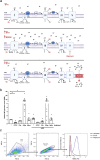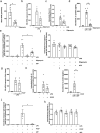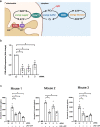Mitochondrial electron transport chain is necessary for NLRP3 inflammasome activation
- PMID: 35484407
- PMCID: PMC9098388
- DOI: 10.1038/s41590-022-01185-3
Mitochondrial electron transport chain is necessary for NLRP3 inflammasome activation
Abstract
The NLRP3 inflammasome is linked to sterile and pathogen-dependent inflammation, and its dysregulation underlies many chronic diseases. Mitochondria have been implicated as regulators of the NLRP3 inflammasome through several mechanisms including generation of mitochondrial reactive oxygen species (ROS). Here, we report that mitochondrial electron transport chain (ETC) complex I, II, III and V inhibitors all prevent NLRP3 inflammasome activation. Ectopic expression of Saccharomyces cerevisiae NADH dehydrogenase (NDI1) or Ciona intestinalis alternative oxidase, which can complement the functional loss of mitochondrial complex I or III, respectively, without generation of ROS, rescued NLRP3 inflammasome activation in the absence of endogenous mitochondrial complex I or complex III function. Metabolomics revealed phosphocreatine (PCr), which can sustain ATP levels, as a common metabolite that is diminished by mitochondrial ETC inhibitors. PCr depletion decreased ATP levels and NLRP3 inflammasome activation. Thus, the mitochondrial ETC sustains NLRP3 inflammasome activation through PCr-dependent generation of ATP, but via a ROS-independent mechanism.
© 2022. The Author(s).
Conflict of interest statement
The authors declare no competing interests.
Figures

















Comment in
-
Creating ATP via creatine kinase B for NLRP3 activation.Nat Immunol. 2022 May;23(5):653-655. doi: 10.1038/s41590-022-01191-5. Nat Immunol. 2022. PMID: 35484409 No abstract available.
References
Publication types
MeSH terms
Substances
Grants and funding
LinkOut - more resources
Full Text Sources
Molecular Biology Databases

